
PDF Publication Title:
Text from PDF Page: 008
comparison is based on gross power block output during TES discharge adjusted for TES parasitic losses in both charge, discharge and standby modes. Table 1 displays calculated parasitic losses for an EnergyNest and molten salt TES for the case of nominal charge/discharge. The design conditions for nominal energy input of 1300 MWhth considers a charge of 8h:45m, a discharge of 11h:15m and a stand-by period of 4h:00m for both TES systems. TABLE 1. TES systems parasitic losses and power block output with design conditions of 1300 MWhth discharge. Parameter Gross power block output HTF pumps; charge (additional HTF for TES) HTF pumps; discharge Salt pumps & auxiliaries; charge Salt pumps & auxiliaries; discharge Salt auxiliaries; stand-by (4 hours) Gross power block output – TES parasitic losses Unit MWhel MWhel MWhel MWhel MWhel MWhel MWhel EnergyNest 480.4 -17.2 -17.3 445.9 Molten salt 492.7 -16.8 -16.1 -8.4 -8.8 -1.8 440.8 Performance has been simulated over four days with variable solar energy; one day with nominal energy and three part-load days. HTF outlet temperature from the solar field is assumed to be 391 °C at all times, whereas the HTF discharge temperature from molten salt is assumed to be 379 °C. Figure 9 shows the HTF inlet/outlet temperature for EnergyNest TES and Table 2 presents a comparison of the gross and net output for both TES systems. The parasitic losses during nominal conditions (Table 1) of charge and discharge are converted to specific losses in MWhel/MWhth and stand-by losses are converted to specific losses in MWel. These specific losses are then used to calculate overall parasitic losses for the three part-load days based on energy charged/discharged and number of stand-by hours. The total electricity output is 1.6 % higher from EnergyNest TES than from molten salt TES due to significantly reduced parasitic losses, mainly due to the avoidance of electricity consumed by the salt pumps and stand-by heat tracing. Future work related to performance evaluation will include: 1) Effect of varying HTF inlet temperatures on solar field efficiency 2) the use of a more accurate model of a 50 MWel power block representing modern CSP plants, 3) days with above nominal energy available for TES, 4) heat losses from the TES systems, and 5) parasitic losses calculated for part load operation. FIGURE 9. Simulated HTF temperature profile for EnergyNest 1300 MWhth TES for four days with variable solar conditions. Charge/ Day discharge [MWhth] 1 1300 2 629 3 757 4 465 TOTAL 3151 TABLE 2. Performance comparison of EnergyNest vs. molten salt EnergyNest Molten salt Gross el. – TES parasitic [MWhel] 440.8 209.7 254.1 152.0 1056.6 Stand-by hours [h] Gross el. [MWhel] 4 480.4 10 230.8 8 279.7 14 166.6 Gross el. – TES parasitic [MWhel] 445.9 214.1 259.6 154.3 1073.9 Gross el. [MWhel] 492.7 238.4 286.9 176.2 080011-7PDF Image | EnergyNest thermal energy storage (TES) technology

PDF Search Title:
EnergyNest thermal energy storage (TES) technologyOriginal File Name Searched:
1-4984432.pdfDIY PDF Search: Google It | Yahoo | Bing
Turbine and System Plans CAD CAM: Special for this month, any plans are $10,000 for complete Cad/Cam blueprints. License is for one build. Try before you buy a production license. More Info
Waste Heat Power Technology: Organic Rankine Cycle uses waste heat to make electricity, shaft horsepower and cooling. More Info
All Turbine and System Products: Infinity Turbine ORD systems, turbine generator sets, build plans and more to use your waste heat from 30C to 100C. More Info
CO2 Phase Change Demonstrator: CO2 goes supercritical at 30 C. This is a experimental platform which you can use to demonstrate phase change with low heat. Includes integration area for small CO2 turbine, static generator, and more. This can also be used for a GTL Gas to Liquids experimental platform. More Info
Introducing the Infinity Turbine Products Infinity Turbine develops and builds systems for making power from waste heat. It also is working on innovative strategies for storing, making, and deploying energy. More Info
Need Strategy? Use our Consulting and analyst services Infinity Turbine LLC is pleased to announce its consulting and analyst services. We have worked in the renewable energy industry as a researcher, developing sales and markets, along with may inventions and innovations. More Info
Made in USA with Global Energy Millennial Web Engine These pages were made with the Global Energy Web PDF Engine using Filemaker (Claris) software.
Sand Battery Sand and Paraffin for TES Thermo Energy Storage More Info
| CONTACT TEL: 608-238-6001 Email: greg@infinityturbine.com | RSS | AMP |